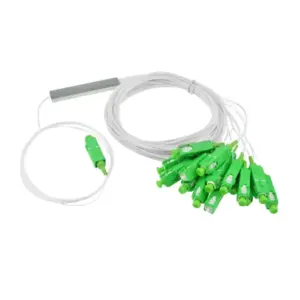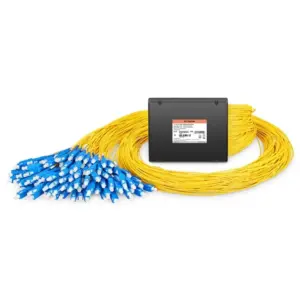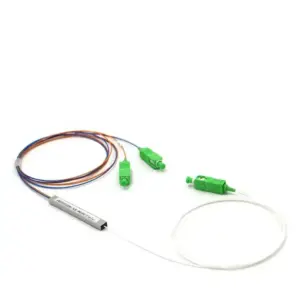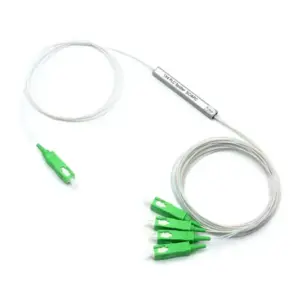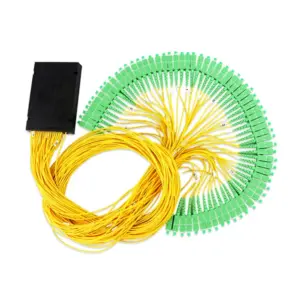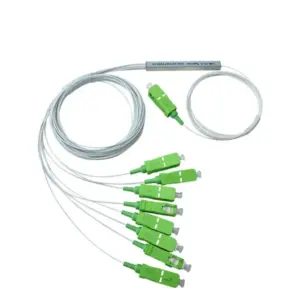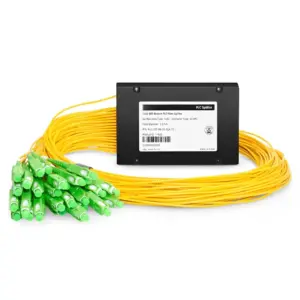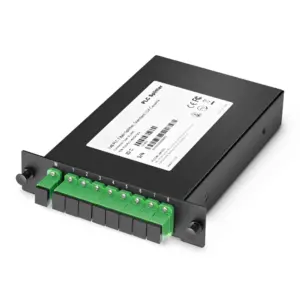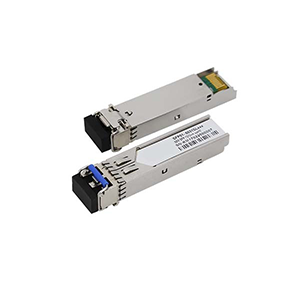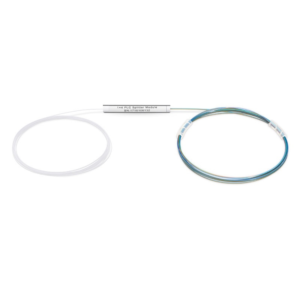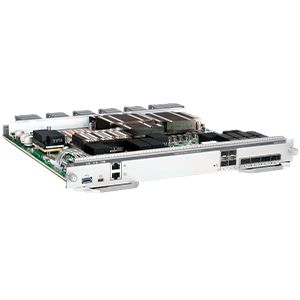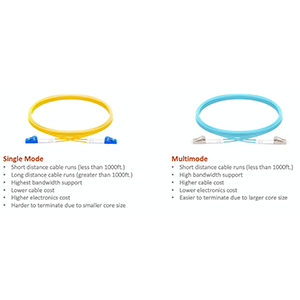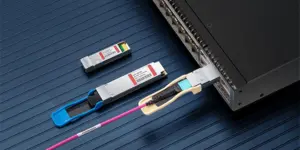Fiber optic splitter plcWith its technical features and advantages such as high splitting ratio and low insertion loss, fiber optic splitter plc plays an irreplaceable role in optical signal distribution and optical networks. By sharing application cases and practical experience in fields such as fiber optic communication systems and data centers, and discussing the future development trends of fiber optic splitter PLC technology, we will take you to have an in-depth understanding of this exciting technology field and provide valuable insights for your business and Project selection provides more inspiration and reference.
1. Understanding fiber optic splitter plc
Optical fiber splitter PLC is an important optical device in the field of optical communications. It has the following basic concepts and definitions:
Fiber Optic Splitter PLC is a device based on optical waveguide technology, used to distribute input optical signals to multiple output channels or combine multiple input signals into one output signal. It is based on optical waveguides on planar waveguide chips and achieves distribution and merging of optical signals through precise optical design and manufacturing processes.
In optical communications and networks, fiber optic splitter PLC plays a vital role:
Optical signal distribution:
- In optical communication systems, fiber optic splitters PLC are responsible for distributing optical signals from light sources to different destinations, such as different terminal devices or different network nodes.
- It can divide the optical signal into multiple parts, so that a single light source can serve multiple targets and realize the sharing and multiplexing of optical signals.
Optical Signal Merging:
- Fiber Optic Splitter PLC can also combine optical signals from different sources into a single output signal for gathering and transmitting data.
- In optical networks, it can effectively integrate multiple optical signals, simplify the network structure, and improve transmission efficiency and network capacity.
The role and importance of optical fiber splitter PLC is that it can realize flexible distribution and combination of optical signals, providing key support for the construction and operation of optical communication systems. It not only improves the flexibility and scalability of optical networks, but also reduces the cost and complexity of the system. It is one of the indispensable key components in modern optical communication systems.
2. Working principle and structure of fiber optic splitter plc
1. Internal structure and components:
-
Planar waveguide chip: It is the core component of the optical fiber splitter, usually made of silicon-based or silicon-based nitride and other materials. Precision-engraved optical waveguide structures are present on the surface of the chip to guide and distribute optical signals.
-
Input optical fiber port: used to receive input optical signals.
-
Output optical fiber port: used to output distributed or combined optical signals.
-
Coupler: Located inside the planar waveguide chip, it is used to distribute the input optical signals to different waveguide channels or combine the optical signals of multiple channels together.
2. Working principle based on planar optical waveguide technology:
-
Optical signal introduction: The input optical signal enters the optical fiber splitter through the input optical fiber port.
-
Coupler distribution: After the optical signal enters the planar waveguide chip, it is distributed through the coupler. Couplers are designed to distribute optical signals to different waveguide channels.
-
Optical signal distribution/merging: Inside the planar waveguide chip, the optical signal is transmitted along the designed optical path. According to the design of the waveguide, the optical signal can be distributed to different output ports, or multiple input signals can be combined into one output signal.
-
Output optical signal: Finally, the distributed or combined optical signal is output through the output optical fiber port and transmitted to the target device or network node.
The advantages of planar optical waveguide technology lie in its compact structure, low loss, and high integration, which can achieve efficient optical signal distribution and merging. Based on this technology, fiber optic splitter PLC can flexibly meet the needs of different optical communication systems and is one of the key components in optical networks.
3. Technical features and advantages of fiber optic splitter plc
1. High splitting ratio and low insertion loss features:
-
High splitting ratio: Fiber splitter PLC can achieve high splitting ratio, that is, the input optical signal is distributed to different output channels according to a preset ratio, ensuring the effective distribution and utilization of optical signals.
-
Low insertion loss: Insertion loss is the degree of signal attenuation of the optical signal after passing through the optical device. Fiber Optic Splitter PLC has the characteristics of low insertion loss, which can maintain the intensity of optical signals, reduce energy loss during signal transmission, and ensure signal quality and stability.
2. Application advantages in optical signal distribution and optical networks:
-
Flexible optical signal distribution: Fiber optical splitter PLC can distribute a single input optical signal to multiple output channels to achieve flexible distribution of optical signals. This flexibility can meet the signal distribution needs of different optical communication systems.
-
Simplified network structure: Through the optical fiber splitter PLC, multiple optical signals can be combined into one output signal, thereby simplifying the structure of the optical network, reducing the number of components and connections, and improving the reliability of the network sex and stability.
-
Efficient optical network construction: The high splitting ratio and low insertion loss of fiber optic splitter PLC enable optical networks to be constructed in a more efficient and economical way. It provides important technical support and solutions for the construction of optical networks.
In summary, fiber optic splitter PLC has the characteristics of high splitting ratio, low insertion loss, as well as the advantages of flexible optical signal distribution and simplified network structure, making it play an important role in optical communications and networks, becoming It is one of the indispensable key components in optical network systems.
IV. Fiber optic splitter plc application scenarios
Fiber optic splitter PLC plays an important role in various application scenarios, including practical applications in fiber optic communication systems, data centers, cable TV networks, etc.
1. Application cases in optical fiber communication systems:
-
Optical fiber access network (FTTx): In fiber-to-the-home (FTTH), fiber-to-the-building (FTTB) and other access networks, the fiber splitter PLC is responsible for introducing optical signals from the central office to the user’s home or home. Buildings realize the distribution of optical signals.
-
Fiber optic sensing network: In the fiber optic sensing system, the fiber optic splitter PLC is used to distribute optical signals to different sensing units to monitor physical quantities such as temperature, pressure, strain, etc.
2. Data centers, cable TV networks and other fields:
-
Data center: In data centers, fiber optic splitters PLC are widely used in optical interconnection and data transmission to achieve data distribution and aggregation and improve the transmission efficiency and reliability of the data center.
-
Cable TV network: In the cable TV network, fiber optic splitter PLC is used to distribute optical signals to different user terminals to realize the transmission and distribution of cable TV signals.
-
Fiber optic sensing network: Fiber optic splitter PLC is also widely used in industrial automation, security monitoring and other fields for optical signal processing and distribution in sensor networks and monitoring systems.
Optical fiber splitter PLC plays a key role in these application scenarios, providing reliable signal distribution and processing solutions for optical communications and data transmission, and promoting development and progress in various fields.
5. Future development trend of fiber optic splitter plc
1. Technological innovation and development direction:
-
Multi-wavelength support: In the future, optical fiber splitter PLC will pay more attention to supporting the distribution and combination of multi-wavelength optical signals to meet the needs of multi-wavelength optical communication systems such as dense wavelength division multiplexing (DWDM).
-
Miniaturization and integration: With the development of technology, fiber splitter PLC will tend to be miniaturized and integrated, achieving smaller size and higher integration devices to adapt to dense integration and high Density layout requirements.
-
Low loss and high performance: Future fiber splitter PLCs will continue to pursue lower insertion loss and higher performance, and improve the optical performance and signal processing capabilities of the device by optimizing the design and manufacturing process.
2. Development prospects in emerging technologies such as 5G and the Internet of Things:
-
5G Communication: With the popularization and application of 5G communication technology, fiber optic splitter PLC will play an important role in 5G base stations and fiber optic post-transmission networks to support high-speed and large-capacity data transmission requirements.
-
Internet of Things: In the field of Internet of Things, fiber optic splitter PLC can be used to connect and manage a large number of Internet of Things devices, realize data distribution and aggregation, and support application scenarios such as smart homes and smart cities.
-
Industrial automation: In the field of industrial automation, fiber optic splitter PLC can be used to monitor optical signals in sensor networks to achieve real-time monitoring and control of industrial equipment and production processes.
The future development of optical fiber splitter PLC will revolve around technological innovation and application expansion. It will not only play an important role in the fields of optical communications and networks, but will also find broader application prospects and applications in emerging technologies such as 5G and the Internet of Things. Development Opportunities.
Summary:
Optical fiber splitter PLC is a pearl in optical communication technology, providing a solid foundation for connecting the world. Its technical features such as high splitting ratio and low insertion loss, as well as its application advantages in optical signal distribution and optical networks, make it an industry leader.
When you choose our fiber optic splitter plc, you not only gain the leading edge in technology, but also receive support and services from a professional team. Let us work together to create the future of optical communications and inject new vitality and power into your business and projects!
-
128-channel optical fiber PLC splitter
-
16-channel optical fiber PLC splitter
-
2-way optical fiber PLC splitter
-
32-channel optical fiber PLC splitter
-
4-way optical fiber PLC splitter
-
64-channel optical fiber PLC splitter
-
8-channel optical fiber PLC splitter
-
ABS module PLC fiber optic splitter
-
Box PLC optical fiber splitter

